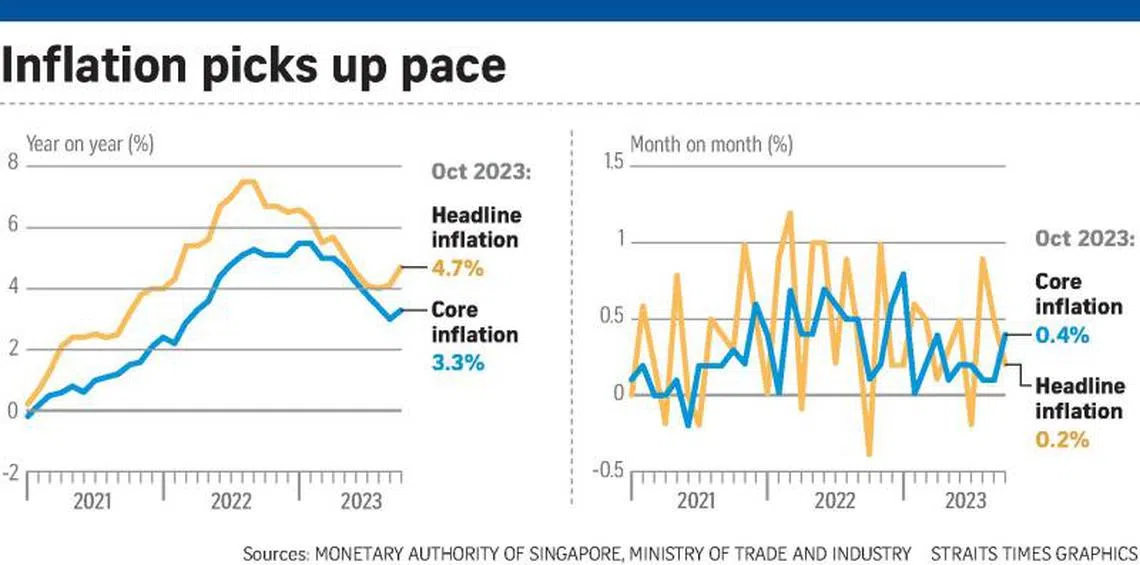S’pore core inflation edges up to 3.3% in October, breaking streak of slower price increases
Sign up now: Get ST's newsletters delivered to your inbox

The increase in core inflation broke a five-month-long streak of core consumer prices rising at a slower pace.
PHOTO: ST FILE
Follow topic:
SINGAPORE – Core consumer prices in Singapore picked up in October after rising at a slower pace for several months, owing to higher inflation for services and retail goods and an increase in electricity and gas costs.
Consumers can expect more volatility in overall inflation in the coming months amid swings in certificate of entitlement (COE) premiums and global oil prices, although prices are expected to moderate in 2024.
Official data on Nov 23 showed that core inflation, which excludes private transport and accommodation costs to better reflect the expenses of Singapore households, stood at 3.3 per cent year on year in October.
This was higher than the 3 per cent seen in September, and the 3.1 per cent median estimate from economists polled by Bloomberg.
The increase in core inflation broke a five-month-long streak of core consumer prices rising
DBS economist Chua Han Teng said the increase in October marked the first uptick since January 2023, when core inflation rose to 5.5 per cent, from 5.1 per cent in December. The increase stemmed from the 1 percentage point goods and services tax (GST) hike to 8 per cent.
Core inflation dropped to 5 per cent in March and was unchanged in April, before decreasing further.
“While inflation has been moderating over the course of 2023, October’s uptick kept price increases high versus the pre-pandemic average,” said Mr Chua.
Meanwhile, overall or headline inflation edged up to 4.7 per cent year on year in October, from 4.1 per cent in September.
This reflected higher private transport inflation as car prices rose at a faster pace, as well as the rise in core inflation, said the Monetary Authority of Singapore (MAS) and Ministry of Trade and Industry (MTI).
The figure was slightly higher than economists’ median forecast of 4.5 per cent.
Data showed that private transport inflation jumped from 8.5 per cent in September to 11.7 per cent in October.
Services inflation stood at 3.4 per cent, up from September’s 3.1 per cent, mainly due to a larger increase in holiday expenses. Tuition and other fees, as well as outpatient and hospital services costs, also rose at a faster pace.

Inflation for retail and other goods inched up from 0.9 per cent in September to 1.6 per cent in October, as the prices of personal care products and medical goods rose more strongly. Clothing and footwear prices fell at a slower pace.
Electricity and gas costs rose by 1.8 per cent in October due to higher tariffs,
Food inflation eased due to smaller increases in the prices of non-cooked food and prepared meals, and accommodation inflation similarly dipped due to a moderation in the pace of increase in housing rents.
Mr Chua noted that food inflation moderated to its lowest rate since early 2022.
Barclays senior regional economist Brian Tan said the bank’s “supercore” measure of inflation – which takes out uncooked food, energy and travel-related items from the official core inflation definition – edged up from 3.2 per cent year on year in September to 3.3 per cent in October, largely due to healthcare inflation.
“From a sequential perspective, our estimates show supercore inflation momentum picking up again,” he added, noting that the indicator picked up pace from 0.2 per cent in September to 0.4 per cent in October, when compared month on month and seasonally adjusted.
On a month-on-month basis, which represents how much momentum there still is in prices, core consumer prices rose 0.4 per cent in October, while overall prices rose 0.2 per cent, said MAS and MTI.
Global crude oil prices have been volatile, falling sharply in recent weeks after rising earlier, they said.
“Meanwhile, global prices for most food commodities, as well as intermediate and final manufactured goods, have continued to moderate. These factors, alongside the stronger Singapore dollar trade-weighted exchange rate, should further temper Singapore’s import cost pressures in the quarters ahead,” they added.
At home, labour costs are expected to increase at a slower pace, in tandem with a gradually cooling labour market.
Higher labour costs are likely to continue feeding through to consumer prices, but at a more gradual pace, said MAS and MTI.
They reiterated their previous forecasts for core inflation to ease to between 2.5 per cent and 3 per cent year on year by December, and slow to an average of between 2.5 per cent and 3.5 per cent for the full year in 2024.
They added that headline inflation is expected to average around 5 per cent for full-year 2023, and 3 per cent to 4 per cent for 2024.
In early 2024, core inflation is expected to be impacted by the increase in the GST rate and seasonal effects, said MAS and MTI.
However, it will likely moderate over the course of the year as import cost pressures decrease and tightness in the labour market here continues to ease, they added.
Meanwhile, there might be more fluctuations in headline inflation in the remaining months of 2023 amid recent swings in COE premiums.
Accommodation inflation is also projected to ease as the supply of completed housing units increases.
Excluding the transitory effects of the 1 percentage point increase in the GST rate to 9 per cent,
MAS and MTI flagged risks such as geopolitical conflicts and adverse weather events causing fresh shocks to global energy and food commodity prices. Tightness in the domestic labour market might also be more persistent than expected.
On the other hand, a sharper-than-projected slowdown in the global economy could result in a greater easing of cost and price pressures.


